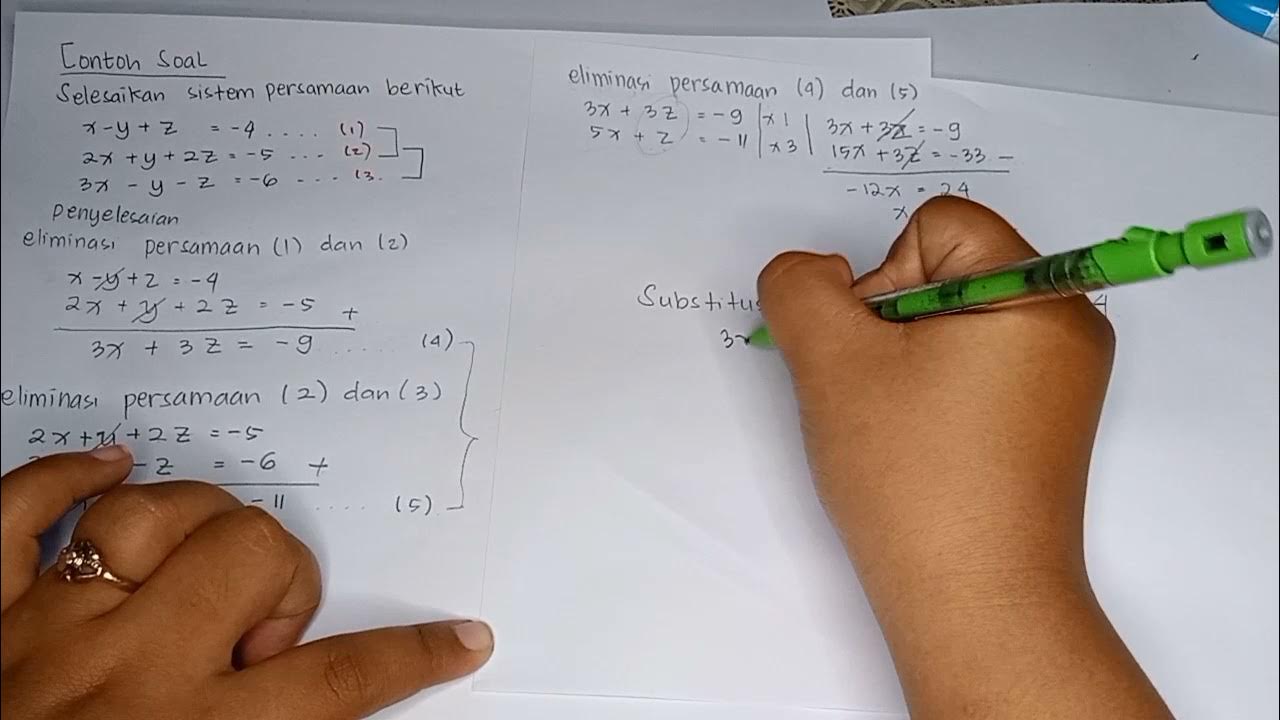Les équations du 1er degré - Maths - 3ème - Les Bons Profs
Summary
TLDRThis video script provides an educational explanation of solving first-degree equations, emphasizing key concepts such as variables (x, y, z) and basic mathematical operations. It covers solving equations through addition, subtraction, multiplication, and division, using simple examples. The script demonstrates how to balance equations, remove terms, and solve for unknown variables, while encouraging verification of solutions. Practical techniques, including the handling of negative signs and coefficients, are explored. The video aims to make solving linear equations accessible by providing clear, step-by-step instructions and encouraging active problem-solving.
Takeaways
- 😀 Equations of the first degree are equalities with an unknown variable (usually represented by x, y, or z).
- 😀 To solve an equation, the goal is to find the value of the unknown variable that makes the equation true.
- 😀 First-degree equations involve no powers higher than 1, unlike second-degree equations that have squared terms.
- 😀 An equation can be solved using various techniques such as addition, subtraction, multiplication, and division to isolate the unknown.
- 😀 The concept of balance is essential when solving equations: what you do to one side of the equation, you must do to the other side.
- 😀 You can subtract or add the same number on both sides of the equation without changing its balance, like taking apples from both sides of a scale.
- 😀 When encountering negative signs, remember that subtracting a negative is equivalent to adding, which can simplify the process.
- 😀 To eliminate multiplication, divide both sides of the equation by the same number. For example, dividing by 3 when x is multiplied by 3.
- 😀 Always verify the solution by substituting the found value of the variable back into the original equation to check if both sides are equal.
- 😀 When faced with a negative variable, such as -x, multiply both sides by -1 to simplify and solve for x.
- 😀 After performing operations like addition, subtraction, multiplication, and division, ensure to check your result through verification to confirm the solution is correct.
Q & A
What is an equation in mathematics?
-An equation is an equality with an unknown value. The unknown is typically represented by variables such as x, y, or z.
What does it mean to solve an equation?
-Solving an equation means finding the value of the unknown variable (such as x) that makes the equality true.
Why is the equation considered 'first degree'?
-An equation is called 'first degree' because the highest power of the variable is 1, meaning no exponents greater than 1 are involved.
What does it mean to manipulate an equation using a balance analogy?
-The balance analogy in solving equations means that operations like adding, subtracting, multiplying, or dividing both sides of the equation maintain the equality, just like adding or removing weight from both sides of a balance scale keeps it balanced.
How can you remove a constant term from one side of the equation?
-You can remove a constant term by performing the inverse operation on both sides. For example, to remove a +2 from one side, you subtract 2 from both sides.
What technique can be used to handle negative signs in an equation?
-When there is a negative sign in front of a variable, you can eliminate it by multiplying or dividing both sides by -1. This changes the sign of the variable.
How do you handle multiplication in equations?
-To remove a multiplication operation in an equation, you divide both sides by the multiplying number. This effectively cancels out the multiplication.
What is the process for solving an equation with both addition and multiplication?
-To solve such an equation, you first handle addition or subtraction to isolate the term with the variable, then perform multiplication or division to solve for the variable.
How do you verify that the solution to an equation is correct?
-You verify the solution by substituting the value of the variable back into the original equation. If both sides of the equation are equal after substitution, the solution is correct.
What are some of the basic operations you can use to solve equations?
-The basic operations for solving equations include addition, subtraction, multiplication, and division. These operations are used to isolate the variable and solve for it.
Outlines

This section is available to paid users only. Please upgrade to access this part.
Upgrade NowMindmap

This section is available to paid users only. Please upgrade to access this part.
Upgrade NowKeywords

This section is available to paid users only. Please upgrade to access this part.
Upgrade NowHighlights

This section is available to paid users only. Please upgrade to access this part.
Upgrade NowTranscripts

This section is available to paid users only. Please upgrade to access this part.
Upgrade Now5.0 / 5 (0 votes)





